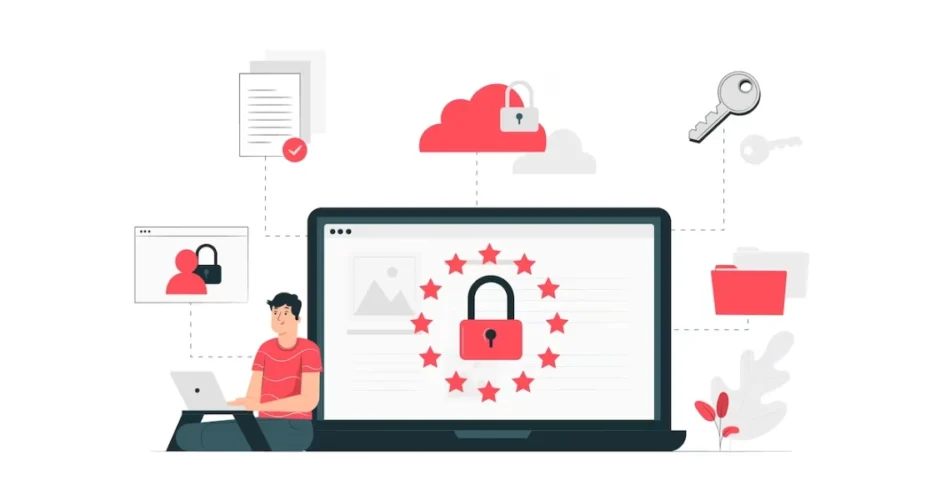We are sure you know what QR Codes are. From product packaging to marketing hoardings, these black-and-white squares are everywhere.
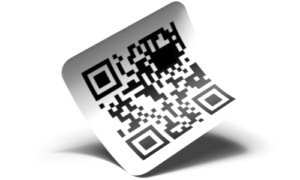
Over the years, QR Codes have become one of the go-to marketing technologies for print marketers. They’re now being used at airports to clear customs, fight crimes, and debug apps.
Besides marketing, QR Codes are popular in industries such as:
QR Code technology is so versatile that using QR Codes for security, like with Google Authenticator, shouldn’t come as a surprise.
Yep, QR Codes for security are a thing, and they’re pretty awesome. Let’s dive into how they work and why they matter.
A. How can QR Codes be used for security?
QR Codes aren’t just for convenience; they can significantly enhance security in various ways. Here’s how:
1. Authentication and verification
One of the coolest uses of QR Codes is for authentication and verification purposes. Imagine you log into a secure website. Instead of typing in a password that could be intercepted, you could simply scan a QR Code that the site generates.
This will prove your identity using multi-factor authentication. It’s similar to possessing a digital lock that only opens with your smartphone or the WPA3 protocol that secures your Wi-Fi connection.
Identification and authentication of personnel can be a tedious process. With advanced features such as password protection, QR Codes have now made this process easier.
Here are three use cases on how QR Codes improve identification and authentication:
I. Tencent’s Smart IDs
Tencent, the Chinese internet giant, launched 900 Smart IDs in Nanning, China. As part of their pilot project, the Smart ID is a unique QR Code.
Tencent developed the Smart IDs in partnership with Nanning’s Public Security Bureau. People can create their Smart IDs via the Tencent app or WeChat (Tencent’s messaging app).
It’s pretty cool to have an ID like this. Most people carry a phone with them all day. We can now pay through WeChat, so why not use it as an ID card. – Zhang Jie, a 23-year-old university student in Nanning.
To create a Smart ID, the user has to send a photo of their ID card on WeChat or the Tencent app. The user will also have to share a selfie for authentication. Once authenticated, the user will receive a QR Code Smart-ID.
To avoid fraudulent use of the QR Code, the code is designed to change every 24 hours – Li, Head of Technology, Public Security Bureau.
Users can currently use the Smart IDs to register for household use. Soon, the Smart IDs could also allow users to:
- Open bank accounts
- Book train tickets
- Apply for a driver’s license
- Check-in at hotels
- Clear security checks
II. CBSE’s question papers
To prevent the leak of class X and XII question papers, CBSE (India) introduced QR Codes on question papers in 2019.
Each subject has multiple sets of question papers, the order of which varies. Each one of these sets carries a QR Code.
These QR Codes can track the leak’s origin and stop its spread.
III. QR Codes on degree certificates
Mumbai University (MU) adopted QR Codes for document verification to curb the menace of fake degree circulation. QR Codes will now be a part of every MU degree to make the authentication process easier.

The current authentication process usually takes anywhere between five days to a month. QR Codes will lessen the time needed to scan the QR code to authenticate the certificate.
In 2015, APJ Abdul Kalam Technical University, Lucknow, also adopted QR Codes for certificates.
In December 2023, the University of Delhi (DU) also announced currency-like security features for their degrees. The college degrees will now feature a QR Code, among other features, to quickly scan and verify students’ details.
Also, AIIMS (India) adds QR Codes to medical certificates to curb fake documents.
IV. Messaging apps
A lot of messaging apps are now using QR Codes for authentication. For example:
i. WeChat
WeChat uses WeChat web QR Codes to allow users to access their chats on desktop
ii. WhatsApp
Just like WeChat, WhatsApp also uses WhatsApp web QR Codes to let users access their WhatsApp chats on a laptop/PC
iii. Android messages
To help people view their Android messages on PC, Google rolled out ‘Android messaged for web’ in 2018
V. QR Codes for tourists/pilgrims
Since Hajj 2015 saw a tragic stampede, the Saudi Government issued QR Code ID bracelets to pilgrims in 2016. These QR Codes are linked to the pilgrim’s name, nationality, medical history, etc.
Also, in 2018, the Police of Ramanathapuram—India—decided to launch an Online Police Verification service. It will help people get verification reports for various cases online and verify their genuineness.
Similarly, you can track the attendees or visitors for any other event or place. Many offices, for example, indulge in NFT ticketing or contactless visitor management. It helps ensure that only authorized people are allowed entry to the premises simultaneously.
That means effective crowd control and management, too. How? This can be quickly done by getting people to register in advance to visit the required premises (and you can also cap how many people can register at a given time slot). It’s just like booking tickets.
Once a registration is made, the user receives a digital entry pass on their phone. This can then be scanned by the guards at the office/event premises to verify authorized entry.
The above use cases show how QR Codes have carved a niche for themselves in security. If you are looking for ways to make your processes more secure, you should also use a safe QR Code generator.
VI. QR Codes for time-based access control
Innovative mobile access control systems, like those produced by Avigilon, use QR Codes to provide guests with temporary access credentials. Rather than issuing costly physical credentials to visitors that could be stolen or misused, a QR Code containing time-based credentials can be sent to the user’s mobile device.
This means delivery drivers, hotel guests, gym customers, and other similar users can enter specific locations as and when required, with permissions automatically revoked after a set period to prevent unauthorized access at a later date.


2. Secure Payments
Ever worried about card skimmers or insecure payment gateways? Well, QR Codes can help here, too.
Most modern-day payment apps have started using QR Codes for safety and to facilitate secure transactions. The payment details get encrypted while the code is scanned to avoid fraudulent activities.
Moreover, it is more secure since you do not hand over your card or type in all those details.
Giants like Alipay and WeChat Pay dominate mobile payments in China. The user links their bank account or credit card to the app and pays by scanning merchant-displayed QR Codes, eliminating physical cards and reducing security and theft risk.
Similarly, secure QR code payments through apps like Paytm and PhonePe have increased in India. You can pay bills, shop online, and even send money to friends using QR Codes—all from the safety of an app.
3. Encrypted information sharing
Sharing sensitive information can be tricky. QR Codes can be used to share encrypted information securely.
For instance, healthcare providers can share patient records using QR Codes that only authorized personnel can decode. This ensures that sensitive data doesn’t fall into the wrong hands.
Oh, well we’re at it, did you know that FDA regulations need QR Codes to be used for export certifications, medical equipment, etc.?
4. Access control
QRs also come in handy in access control. QR Codes can grant or deny access, whether it is entry to secure facilities or digital files with confidential information, or Secret QR Codes to unlock hidden messages/surprises.
You could generate a unique QR Code for every user that shall be scanned to verify who the user is and what he/she is allowed to do.
The India digital payment revolution is spilling over into healthcare through UPI, with government data demonstrating a surge in digital adoption.
It extends beyond the significant cities to even leading states like Uttar Pradesh. Over one lakh patients across India are registered at hospital outpatient departments using QR codes daily.
Notably, Uttar Pradesh has witnessed the most significant uptake, registering over 86 lakh QR Code-based registrations. This data suggests a promising shift towards a more efficient and streamlined healthcare experience for patients across India.
5. Tracking and traceability
QR Codes are now used to track products and ascertain product authenticity in logistics and supply chain management industries.
It helps prevent counterfeiting and ensures authenticity. Scanning the QR Code makes it possible to trace the product journey from manufacturer to consumer.
Big names like Denso, Toyota, and Maruti are already using these QR Code tracking techniques to track their equipment throughout its lifecycle and figure out damaged or counterfeit products.
Globally, approximately 1.3 million people succumb to injuries every year caused by road accidents.
Such incidents worry people about loved ones who step out. What can we do to keep a check and put such concerns to rest?
To address this concern, some organizations have developed tracking apps. With the help of QR Codes, the app allows users to track the whereabouts of their family and friends on the go.
Listed below are use cases from two such apps:
A. BusWays
Boston University graduates Pedro Guimaraes and Fernando Nazario co-founded BusWays. BusWays is a QR Code tracking app that allows schools and parents in Panama to track the location of the bus and kids.
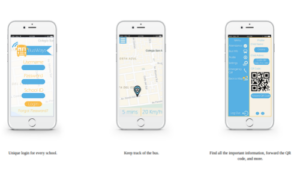
The app provides a unique QR Code tag for each child. Parents can attach these tags to the child’s backpack. When the child gets on or off the bus, a school attendant scans the QR Code. Scanning the QR Code will notify the parents of their child’s location via the app.
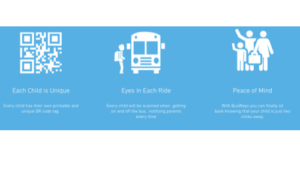
The security isn’t big there (Latin America). I noticed my mom and other parents would get very worried about the children. My mom would call me all the time asking if my brothers were on the bus with me, where the bus was. I came up with the idea. How can we fix this issue? Why is this happening?
Pedro Guimaraes, Co-Founder, BusWays.
BusWays gives approved schools access to an admin portal to view data on their buses. Using BusWays, schools can view the bus’ speed and the routes they take. Also, the app allows schools to check the attendance of their passengers.
B. Track Me
The safety of passengers using public transport is a concern in India, especially after dark. To ensure passenger safety, Software Technology Park of India has developed the Track Me app.
The Track Me app is currently only available in Bengaluru, India. The app allows passengers to view the driver’s details by scanning a QR Code. Once scanned, the passenger can share the details with their family members.
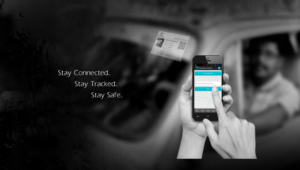
The app covers public transport vehicles such as cabs, buses, and autorickshaws. The app also works without an internet connection so that safety is not compromised.
Our app informs family members right at the start of the trip of the person’s whereabouts and continues to confirm throughout the trip if the passenger is fine or not. The unique pin system ensures that the driver cannot tamper with the app.
Prasenjeet Pati, Developer, Track Me app.
Besides driver details, the app allows passengers to calculate estimated fares based on distance. Track Me app also provides uninterrupted route tracking.
The app is live on the Google Play Store.
C. Kent CamEye
People who have a chauffeur-driven car are always concerned about its safety.
To help them monitor the car and ensure that the driver doesn’t misuse the vehicle, Kent launched Kent CamEye in March 2019.
It is an easy ‘do-it-yourself’ installation that syncs with your smartphone to notify you every time your vehicle reaches a destination, exits a location, etc.


B. Stay Cautious: Not all QR Codes are created equal
While, on their own, they offer a great deal of security benefits, there’s a need to be very careful of potential QR Code security issues.
Scammers can create malicious QR Codes that redirect you to phishing sites or download malware onto your device. To combat these threats, it’s important to understand the QR Code risks and their solutions.
Here are some quick tips for staying safe:
- Verify the Source: Only scan QR Codes from trusted sources.
- Use a QR Code Scanner with Security Features: Some scanners can detect malicious QR Codes.
- Check the URL: Before opening a link from a QR Code, ensure it’s legitimate.
C. The future of QR Codes for security
QR Codes are immense in their potential capacity for improving security. As technology evolves, we will likely see even more creative uses.
From biometric authentication to the most advanced encryption methods, QR Codes will be vital in securing our digital interactions.
Next time you see a QR Code, remember it’s not just a fancy way to open a menu or make a payment. It’s a powerful tool helping make our digital world a bit safer. Happy scanning!
Feel free to share your thoughts or any cool uses of QR Codes you’ve come across in the comments below. Let’s keep the conversation going!
D. FAQs on QR Codes for Security
1. Are QR Codes secure?
QR Codes themselves are just a way to store information. They’re no more inherently insecure than a regular barcode.
However, malicious actors can use them to direct you to harmful locations.
2. How can I identify a fake QR Code?
Fake QR Codes are designed to trick users into visiting malicious websites or making unintended payments. To identify one, always check the context—avoid codes on suspicious posters, unofficial emails, or unverified sources. You can also use preview features in QR scanning apps to see the URL before opening it.
Read our complete guide on spotting fake QR Codes
3. Can scanning a QR Code give your device a virus?
A QR Code itself cannot directly infect your device. But it can lead you to a harmful website that might attempt phishing or malware downloads. That’s why it’s important to verify the source before scanning.
Learn more about QR Codes and virus risks
4. Are QR Codes dangerous to use?
QR Codes are safe when used correctly. However, like any technology, they can be misused by bad actors. The key is to scan only trusted QR Codes, especially when they involve payments or personal information.
Learn about QR Code dangers and how to stay safe in our detailed guide.
5. What are some security risks of QR Codes?
Some security risks of QR Codes include:
Phishing: QR Codes may redirect to fake websites to acquire your logins or details of your credit card information.
Malvertising: While scanning a QR Code, malware might unknowingly get downloaded onto your device.
QRLjacking: Hackers replace real QR Codes with malicious sites.
Data leaks: Malicious interception of the QR Codes containing sensitive information, such as password data, if not handled properly.
6. How do I safely scan QR Codes?
Use a trustworthy scanner app: Though most phone cameras come with built-in scanners, consider using a reputable third-party application that allows one to preview the destination URL.
Carefully evaluate the URL: Do not click shortened URLs blindly. Avoid the code if it looks suspicious, such as with misspellings or unrelated domain names.
Beware of public QR Codes: Do not scan codes from unknown sources, and more so if it seems too good a deal to be true, like free present offers.
7. Can QR Codes be used for secure transactions?
Yes. If implemented correctly, QR Codes can be secure for payments.
Some systems use encryption and require additional verification, like fingerprint scanning.
8. What are security tips for QR Code payments?
Only scan codes from trusted vendors: Use another payment method if a vendor seems suspicious.
Check the amount before you pay: Make sure the payment amount displayed on your phone is correct before you make the transaction.
Use a QR Code payment app that has advanced security.
9. How can I tell if a QR Code is legitimate?
Unfortunately, there’s no foolproof way to identify a legitimate QR Code visually. However, contextual clues can raise red flags. Look for inconsistencies: is the code displayed on a professional website or a random flyer on the street?
10. What should I do if I scan a malicious QR Code?
If you suspect you’ve scanned a malicious code, immediately close the opened website or app. Run a security scan on your device using your trusted antivirus software. Consider changing your passwords if you entered any sensitive information.
11. Is it safe to generate my own QR Codes?
Yes, generating QR Codes for personal use is generally safe. However, use a reputable QR Code generator and ensure the information encoded is appropriate for sharing publicly.
12. Can QR Codes be used for two-factor authentication?
Yes, QR Codes can be an extra layer of security in two-factor authentication. When logging into an account, a QR Code might be displayed on your phone that you scan with another device to confirm your identity.
13. What’s the future of QR Code security?
As QR Code usage grows, security features are likely to evolve. We might see more dynamic QR Codes that change after a single scan or require additional user verification before revealing the information.
